Hiropon: Takashi Murakami's Early Digital Works
NOTE: The artwork discussed in this article contains explicit nudity and sexual content. Excerpts of the work are depicted for the purpose of commentary.
I'd like to express my gratitude to Nice Gear Games for translating the audio to the Macintosho version of Hiropon. I'm also thankful to frequent collaborator Etienne, without whom I wouldn't have access to either the digital Hiropon or Japan Art Today 07.
Takashi Murakami, among Japan's most famous living artists, is known for high-spectacle, attention-grabbing artwork in his "superflat" art style which fuses high art with elements of manga, anime, and commercial art. But among his catalogue, alongside the flowers and the merchandisable Mr. Dob, there's one work that stands out as both a shock and a polarizing mystery: Hiropon. Although Hiropon remains the subject of much debate, little-discussed early versions of the work—including a rarely-seen digital animation from 1993—provide key clues to her meaning.

A sculpture first exhibited in 1997, Hiropon is a looming, larger-than-life anime character who stands at two and a quarter meters (7'4"). An adolescent female figure just barely dressed in a bikini slipping from her breasts, as she hangs suspended in motion skipping on a jumprope made from her own breastmilk. Her exaggerated proportions barely fit within the eye's frame at a glance, commanding attention no matter where she's installed. Hiropon is often (though not universally; see McQuilten, 2013) taken as a criticism of otaku sexuality, but her exact message remains a puzzle—and she marks a significant departure from the character of the rest of Murakami's work[1].
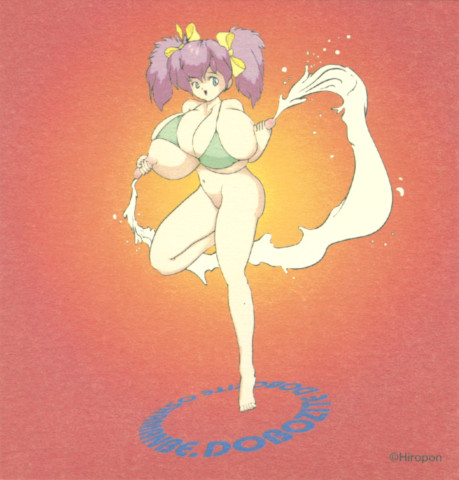
It's tempting to read Hiropon as an attention-seeking stunt, or a prank. Certainly, there's a prankishness to her that's only enhanced by seeing her in a gallery with more "serious", "ordinary" work. The essential joke of placing Hiropon in the gallery is that it forces a more serious, aesthetic interpretation that her "low art" peers are denied. Critics describe her "miraculous, rather decorative suspension of bodily fluids, the big colorful prisms of the eyes that suggest abstract paintings" (Smith, 1999). Shock value only lasts so long, as Smith notes; any critic who doesn't simply dismiss her out of hand is forced to consider the artistic qualities of her components, breaking her down into pieces that can be considered at a time; the form of her bodily fluids here, the curve of a breast there. But is she just a joke on the critic? What else might be here?
Though it's by far the most famous, this isn't the only Hiropon. Aside from the sculpture, there are two other Hiropons who are rarely written about: a series of paintings and a digital animation, both exhibited four years earlier in 1993. These proto-Hiropons lack both the focus and the success of the sculpture, but studying them provides crucial detail that helps to bring the later work into focus.
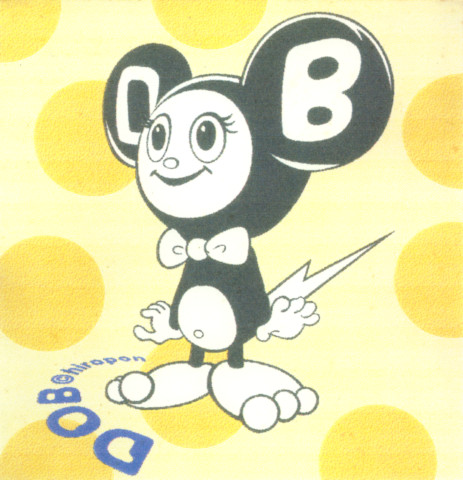
Hiropon has her origins in a project to establish recurring characters in his work, a sort of high art world response to Hello Kitty and other mascot characters. In Japan Art Today 07, a digital art magazine published in 1993, he describes sketching out three such characters: Mr. Dob, who would become the central recurring character of his career; Hiropon; and an obscure figure known as Daniel III (ダニエル3世) (Nakazawa, 1993). While Mr. Dob draws explicitly from character merchandising, Murakami cites a more underground influence on Hiropon. He describes having visited Comiket, a large-scale comic market where artwork and goods are sold by independent artists, where he saw a piece of artwork of a young-looking female figure posing with lactating breasts; this became the model for Hiropon (Nakazawa, 1993).
Two different paintings by the Hiropon name were shown at his early exhibitions, including 1993's "A Romantic Evening" (Nakazawa, 1993), held from October to November at Gallery Cellar in Nagoya (Sotheby's, 2003). Painted on aluminum, these versions lack the sculpture's imposing presence but feature a number of the ideas that would eventually become the focus of the sculpture. Like the later version, these Hiropons focus very specifically on an adolescent figure exaggerated to the point of distortion, with enormous breasts that feature cow teat-like nipples. The key piece for this exhibition, as depicted in contemporary reviews (Nakazawa, 1993) and later exhibitions, isn't the Hiropon that would become famous later but a reclining figure whose body seems to be almost melting under the weight of her exaggerated physique and whose nipples are pierced in a way that calls to mind a cow's nosering. The secondary work (seen at the top of the article), meanwhile, is clearly the model of the sculpture: nearly the same pose, represented two-dimensionally, and suspended over the looped phrase "dobozite, dobozite, oshamanbe"—a key phrase in Murakami's early art, frequently associated with Mr. Dob. (Mr. Dob himself, in fact, was first exhibited in A Romantic Evening (Ngai, 2005)).

Hiropon wasn't yet a central character in his ouvre, and even the name "Hiropon" wasn't exclusively hers. Rather, "Hiropon"—both a cutesy misspelling of "heroin" and a reference to a methamphetamine drug developed by the Japanese government during World War II (Kelts, 2012)—was a common name used across Murakami's early works. Already by 1993, works from both A Romantic Evening and Macintosho feature the text "© Hiropon", and when Murakami founded his Warholian art factory in 1996 he would name it "Hiropon Factory" before eventually settling on its current name, "Kaikai Kiki" (Gagosian, 2018).
These Hiropons would feature in exhibit retrospectives (Nakazawa again, 1993), but they wouldn't hold the central position of his early work that the sculpture tends to today. They're both literally and figuratively two-dimensional, simpler and less spectacular works than the later sculpture. Rather, the key works of this exhibit seem to have been the initial Mr. Dob painting and Shellmet, a sculpture of a retro-futuristic helmet (see photo above). Hiropon wouldn't take center stage until the following month, when a new version of her would debut exclusively at the small new media art show Macintosho.
The Macintosho[2] exhibition, held October 30 to December 26 1993 (bxjp, 2021), was organized by new media publisher Digitalogue. (Longtime readers may remember Digitalogue from the article on The Reactive Square.) This was in the earliest days of computer art, and the question how exactly to exhibit a digital work was still in the open. (Across the ocean, Olia Lialina memorably describes the "zoo"-like atmosphere from trying to capture a digital work—and its artist—and place it in a bottle for exhibition (2020).) The exhibition they settled on was a hybrid: at once physical and digital, in the gallery and in the patron's home, and focused exclusively on the Macintosh computers that the scene's adherents preferred. It consisted of 21 original works by a variety of artists, all commissioned for the exhibition, where attendees could try them out for themselves or buy a copy to bring home for their own home computer (bxjp, 2021). Reviewing the list shows a fascinating variety; it includes artists who are well-known now (Murakami, Gabin Ito), artists who were well-known within the early computer art career without having broken into the mainstream (Hideki Nakazawa, Gento Matsumoto) and many others who remained in the underground.
It's surprising to see Murakami in a digital exhibition this early in his career, at a time when he was focused exclusively on traditional media, but he was already well-acquainted with Digitalogue and the other organizers of Macintosho. He has described Digitalogue-affiliated artist Gento Matsumoto's influence on Hiropon's composition (Nakazawa, 1993), and A Romantic Evening was attended by Hideki Nakazawa; it was the sole focus of issue 7 of his early electronic art magazine Japan Art Today.
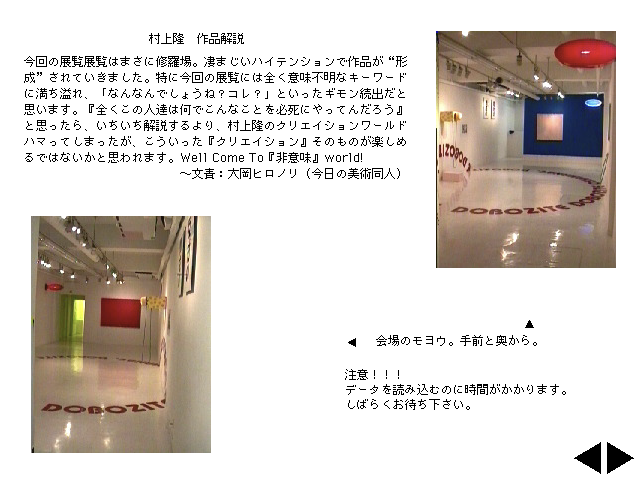
Murakami's entry to Macintosho was a hybrid work combining both a floppy disk and several traditional artworks. While the staging of the physical exhibit isn't clear from available retrospectives, the purchaseable floppy disk featured five small-form 3.5" prints which served as cover sheets; they may have been physically exhibited alongside the computer. It naturally features replicas of the two Hiropon paintings from A Romantic Evening, with the reclining figure as the primary image. The other prints include an early version of his Mushroom Bomb series, as made famous much later in the Time Bokan print series, and his two Seven Stars prints. Mushroom Bomb is a graphic design-inspired piece making use of only two colours and negative space and characteristic bold, defining lines. (A copy is reproduced at the top of this article.) It depicts a a mushroom cloud explosion in the shape of a skull, recalling the stylized skull designs of both the Time Bokan and Captain Harlock anime series. Seven Stars, meanwhile, features minimalistic geometric patterns which suggest a woman's legs and a nude figure.
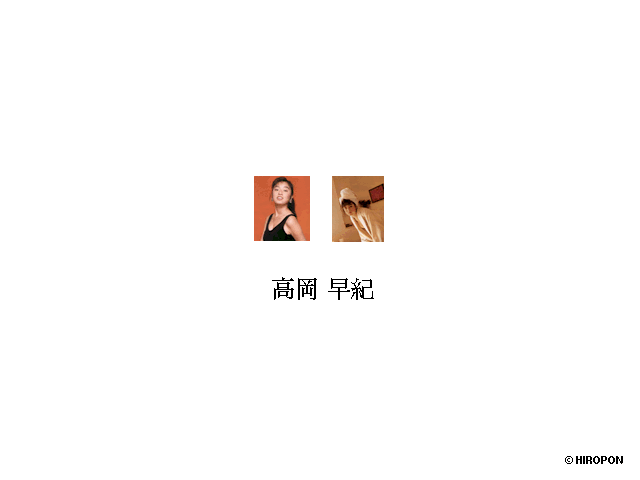
Hiropon the software is an altogether stranger work than the paintings. The prints included with the disk may have primed the viwer to expect some form of digital replica of the Hiropon painting, but after only the briefest flash of one of the Seven Stars prints and Mr. Dob's slogan "dobozite, dobozite, oshamanbe", the viewer is presented with a photo of a model—a real flesh and blood woman, that is, not the anime girls that Hiropon purportedly critiques. As several unidentified people chatter at random, it rotates between slides of models—sometimes clothed, sometimes nude—and, finally, a quick sequence of images: the logo of men's magazine Beppin, known for its nude centerfolds; the classic NTT Dial Q2 (ダイヤルQツー) phone service, infamous for its use for phone sex; a photo of a model labelled simply "huge breasts" (きょにゅう); and, at long last, the two images of Hiropon herself labelled "huge breasts 2" (巨乳2).
The effect is disorienting, but not in the same way as viewing Hiropon-the-sculpture herself in person. The background chatter is almost entirely unconnected to the visual content of the work, with the speakers only occasionally making comments that could be considered even tangentially related to the work. The setting—the izakaya[3], or perhaps the implication that this could be a Dial Q2 call—just reinforces the informality and, ultimately, the inessentiality of it. It's noise, a distraction, and perhaps a sound to blend in with the chatter of the surrounding gallery.
Also noteworthy is what this work doesn't have: interactivity, of any form. Unlike some of the other works in the same exhibition, such as Hideki Nakazawa's anarchic Baka Video Drug, Hiropon is entirely insensate to the viewer's touch; there's no way to speed her along, to cause the work to skip ahead or rewind, or to ask any more information of any of the images it presents. The viewer is there for the ride. In traditional video art or paintings the viewer would never expect interactivity, but here as a choice it asks the viewer to take a passive position: viewer, not participant, in the work, much in the way a viewer of pornography interacts with the subject of that media. It's also an interesting contrast to the later sculpture, where it's easy to argue that the experience of walking around the sculpture, of its massive scale confounding attempts to take it in all at once, is itself interactive in a way that this computer artwork isn't.
A hint as to Murakami's intentions with Hiropon can be seen in his 1999 Tokyo Pop Manifesto (as quoted in Superflat Trilogy, 2005, p. 152). Written the year before he would coin the term "superflat", it provides a valuable insight into his thinking in his earlier years. In charting the development of Japan's pop art scene, as distinct from America's, he describes the 20th century history of Japan as living essentially in America's shadow post-occupation. "Our society and hierarchies were dismantled. We were forced into a system that does not produce “adults”. … The growing Japan is burdened with a childish, irresponsible society". The key moment for Hiropon is when he describes Japan as possessing "a value system based on an infantile sensibility"; we can easily draw a line between that "infantile sensibility" and the imagery of juvenile, young women in the kinds of otaku sexuality that Hiropon is drawn from. The actual intent of the work, such as it is, comes in the contrast of the two sexualities over its running time, of "traditional" sexuality versus Hiropon. The men's magazine nude models, the Dial Q2 service for phone sex: this is "adult" sexuality. Hiropon, "huge breasts 2", the next evolution in the history of sexuality: this is the "infantile sensibility". The comparison is only heightened via ironic contrast in how they're written: the real model is given "きょにゅう" in hiragana, a childish and less educated way of spelling it, while Hiropon is given a more complex "巨乳2" in kanji.
McQuilten (2013) makes the case that Hiropon was designed to "directly appeal to the market" while dismissing claims that it acted as a critique of otaku sexuality. She's certainly not wrong; Murakami's attachment to the market is well-documented, and he's openly described himself as a "slave to my customers" (Itoi, 2002, p. 17). Hiropon isn't merely pandering to the market, however, but trapped in an uncomfortable tension where Murakami attempted to pander to the market while actively critiquing it. Producer Shuichi Miyawaki, from the company that produced the Hiropon sculpture, flatly stated that "At present, almost no otaku have accepted Murakami as an otaku artist making objects within the otaku community", and it's clear that Murakami's critiques of otaku sexuality were a major reason for that rejection. He goes on to describe how "Murakami has made some comments about how otaku are uncomfortable with real women, and about their expressions represent exaggerations of repressed desires". In response, Murakami's work became more derivative; the followup to Hiropon, Miss ko² (various editions starting 1997; Murakami, 2001), is conservatively designed, more directly aping otaku figures and less clearly exaggerated than Hiropon. This is what direct appeal to the market without any form of critique looks like, and the result was mediocre. Hobby and toy writer Masahiko Asano bluntly stated that "I don’t consider the first Miss ko² figure to be a work of art. Hiropon and My Lonesome Cowboy were sort of almost what you could call art, but the first Miss ko², constructed in shallow, cheap taste, had no context and nothing worth critiquing about it" (2001, p. 94).
Koga (1993) compares Hiropon to Henry Darger, the American outsider artist whose extensive ouevre focuses on fantastical images of girls[4]. Darger's girls are depicted with penises, an artistic quirk that has been the subject of debate for decades; Koga equates Darger's artistic naïveté with personal naïveté to suggest that he doesn't know his subject, and instead projects his personal self onto his subjects. If he has a penis, why shouldn't the women he's drawing?[5] And so Hiropon stands in as a Darger-esque woman drawn by an otaku naïf, a copy of a copy created by an otaku who lacks a reference to the real object and who has created a bizarre simulacrum out of his[6] own ignorance. Koga also draws a comparison to Hiropon's oddly phallic nipples, making the case we should read them not as a cow's teats but as penises: a Darger-esque assignment of the site of sexual power to the woman, assuming that she must draw power from the same organ the male artist does.
Based on Koga's reading of the naïve, ignorant artist, we could say that the contrast between the real women and Hiropon in the Macintosho work serves to make that comparison more explicit: here are real women, and here is Hiropon, created without reference to real women. Could "huge breasts 2" have been created by an artist with reference to a real woman? it seems to ask. If so, this seems a somewhat puerile comparison; "otaku are just virgins who have never touched a woman" is more of a schoolyard taunt or message board post than the core argument for a gallery work. There are many things that can be critiqued in otaku sexuality, but this critique seems shallow and poorly-considered.
Ignoring Hiropon herself, what are we to make of the images of real-life erotic models used here? Unlike Hiropon, an original work inspired by art Murakami had seen elsewhere, these are lifted directly from somewhere else—presumably without consent or permission. If Murakami is really critiquing otaku sexuality, what does it say that he presents us this catalogue of mainstream men's sexuality? The "appropriation" in Hiropon is stylistic, and filtered through the lens of exaggeration, but these are actual photos of actual models, presented ambiguously as objects of either desire or derision. If we're meant to read Hiropon as a critique of otaku sexuality, are we being presented with these photos as critique of mainstream sexuality or merely as a contrast with a form of normatized, adult sexuality? And if it's the latter, what value does it even serve to display, possibly to appropriate, their images in this way?
We've seen two very different kinds of women in Hiropon—the sexualized anime woman, and the real-world nude models—but where are the men in this work? We have Hiropon herself to represent otaku sexuality and the imagery of nude models to represent "traditional" commercial eroticism, but men are present only in their absence—only the immaterial, almost irrelevant male voice in the audio track serves to actually depict any sort of male figure who's consuming this sexuality. In their absence, it's easy to treat the desirer as an abstraction whose existence is simply presumed, and to instead turn any criticisms of sexuality purely onto the image: it's the image that's ludicrous, the image that's obscene—and, of course, the actual nude model who poses for the photographs who bears the weight of our scorn without any real concern for the implicit man who we understand to be demanding this image. It recalls Berger when he describes the male viewer "morally condemning the woman whose nakedness you had depicted for your own pleasure" (1972, p. 51). It's a critique of sexuality that has no consideration or respect for the women it uses and consumes for its point. It's telling that critical discussion of My Lonesome Cowboy (1998), her male counterpart, tend to adopt a similar framing. Critic Yusuke Minami, for example, summarizes the work as a satire on male sexuality: "demonstrating that this image of a mature “man’s work” is in fact built upon juvenile sexual fantasies" and "artist (=man) seeking a painting (=woman) to subjugate" (2001, pp.59-60). In other words, whether the sculpture is a male or a female figure, the female perspective is somehow always absent: the woman exists just as an image to be consumed and the male perspective is centred.
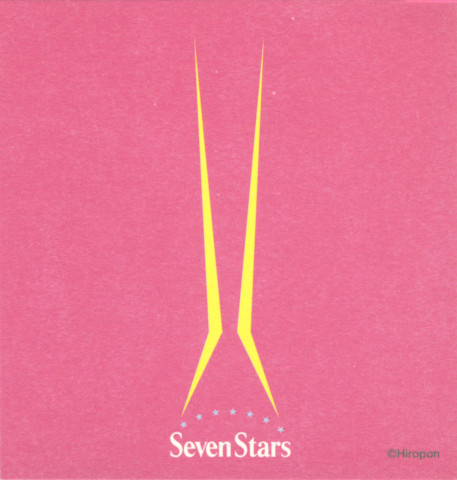
The choice to open the digital Hiropon with an image of Seven Stars is a tantalizing throwaway moment, and a brief snatch of what could have been a more interesting conversation with the rest of his work. Seven Stars's sleek sexuality is a sharp contrast from Hiropon, both as a 2D image and as a sculpture, and the decision to package these works together in the Macintosho package provides a stronger critique than the choice of real-life models in the digital work. Seven Stars, unlike Hiropon, is a work designed in Murakami's typical mould: logo-like cleanliness in design, flawless linework, a superflat approach to colour design and aesthetic. It fits within Murakami's usual approach to pop culture appropriation: to take concepts, snatches of imagery, then build original works from them with the sleekness and expense of a gallery work. Seven Stars, in other words, would be the typical Murakami approach to erotic art in a way that Hiropon isn't; despite opening with a brief flash of Seven Stars, it's surprising that he makes so little of the comparison and leans instead on nude models.
It's also worth contrasting the specifics of Hiropon's style to Murakami's other works from the same period, including the other prints distributed alongside the floppy disk. Murakami was, of course, already drawing from otaku-based art styles at this point, but these other works are qualitatively different. Mr. Dob, even in his earliest iterations, is defined by clean lines and the specifically professional sheen of his mascot-ness. Mushroom Bomb, even in this early version, is defined by the careful definition of its shapes, the attention paid to the minimalist construction of its colour design and facial shape. Hiropon is different in her intentional crudeness: the shakiness of her lines, in contrast to the refinement seen in those other works; the weakness of her anatomy and posing; the slightly wall-eyed expression. Murakami's other work in this period takes the shape of "elevating" mascot- and otaku-based artwork to the gallery, but Hiropon's very style argues against this kind of interpretation.
An interpretation of Murakami's later figure-based work, including the 1997 Hiropon sculpture, might suggest that this is the result of intentionally magnifying a 1:3.5 scale model to a larger-than-1:1 figure. Hobby and toy writer Masahiko Asano (2001) openly describes the issues that he identified in blowing up a figure to such a scale, though they're clearly intentional from Murakami's perspective. There are physical limitations to painting a 1:3.5 scale figure; the Hiropon sculpture's shaky lines and quirks can be easily read as intentionally exaggerating those physical properties past the scale where they're necessary. But for an audience that's seen the 1993 painting, it becomes harder to read the sculpture in the same light. It's not an exaggeration of a miniaturized work with the same physical limitations; it's an intentional choice to stylize the work this way from first principles.
There's a sense of the freak show here: of taking something the viewer clearly sees as degrading or embarrassing, and "elevating" it to the gallery as a way to mock it. Lichtenstein's work most obviously works this way, as a kind of "pop art" that has no actual respect for the work he's lifting, but Hiropon works within the same mode. That essential crudeness, the weak lines and shaky anatomy, tells a story: this isn't work Murakami has respect for, and the mere act of bringing it to the gallery in the first place is his critique. Just like the freak show, too, Murakami is charging a premium for access. Hiropon is physically blown up to a larger size, with her flaws enlarged for the viewer's eye, in the same way that she's transplanted from Comiket to the gallery. Both are a kind of expansion—of scale, of audience—that serve to throw the perceived flaws and technical limitations to a new audience. His major gallery customers would likely never purchase the actual pornography he's drawing from, but they'll buy Hiropon for hundreds of thousands of dollars.
The key illustration for the original Hiropon is, by the standards of the erotic art it aims to critique, almost staid: her breasts are improbably enormous, yes, and so are her nipples, but there's little to nothing to differentiate her from her erotic magazine peers. What makes the sculpture stand out is its next-level absurdity: details such as the jump rope formed out of her own breast milk, the way that she exists in the room, lurking alongside the viewer. One article describes her eyes as "blank white orbs of reflected light sat just off-center" which, when "[v]iewed from other angles... could look menacing" (Kelts, 2012)—an experience and aesthetic genuinely unattainable either on aluminum or in the small scale of an anime figure.
The lack of that transformative exaggeration in the original painting and in the software—the truly absurd step that would actually mark it as being something other than the low art it claims to critique—leaves it languishing as a retread of Lichtenstein's comic paintings. It's an original work, not a direct copy as Lichtenstein made, but the underlying intent is the same: lifting a work of low art and marking it as crude via the juxtaposition of placing it in a new setting. It could have been a direct copy of another work and the work wouldn't have fundamentally changed. It would, in fact, be quite possible to mistake it for erotic art from any magazine or computer game of the era. Reproduction of fundamentally the same imagery fails as meaningful critique.
The sculpture has those same aesthetic qualities as the painting and the software, but the sheer scale and exaggeration goes beyond what those can achieve—and that, in the end, is where the work derives its greatest successes. Whether positive or negative, all of the critics I've cited previously were responding to the work's scale and imposing presence. Her central argument—the somewhat shallow critique of otaku sexuality and the dare to the viewer to take the work seriously in the first place—finally succeeds from her epic scale where these earlier renditions fell short. Her meaning is confused, but can't scale and aesthetics close that gap?
Notes
1. Hiropon's male counterpart, My Lonesome Cowboy (1998), and Miss ko² (1997-2000) stand out in Murakami's work as among the few pieces working in the same vein. ↩2. Alternately spelled "Macinto書", using the character for "book" ("sho"). ↩
3. A traditional Japanese bar. ↩
4. Koga is referring specifically to the Henry Darger Exhibition held at the Setagaya Museum in Tokyo in 1993 (Exhibitions). ↩
5. It should be noted that this interpretation of Darger's work isn't by any means definitive; why exactly he depicted girls the way he did is the subject of much debate. ↩
6. We can readily assume here that the artist is meant to be male; there has been no room for a woman on the artist's side of the camera or brush anywhere in this discussion. ↩